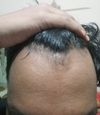community 4 months after adding topical finasteride + melatonin, and switching from dermaroller to dr. Pen
A user's experience using topical finasteride and melatonin to regrow hair, as well as their use of dermaroller versus dr. Pen for microneedling. People discussed the benefits of oral minoxidil and questioned if melatonin could help with hair regrowth.
